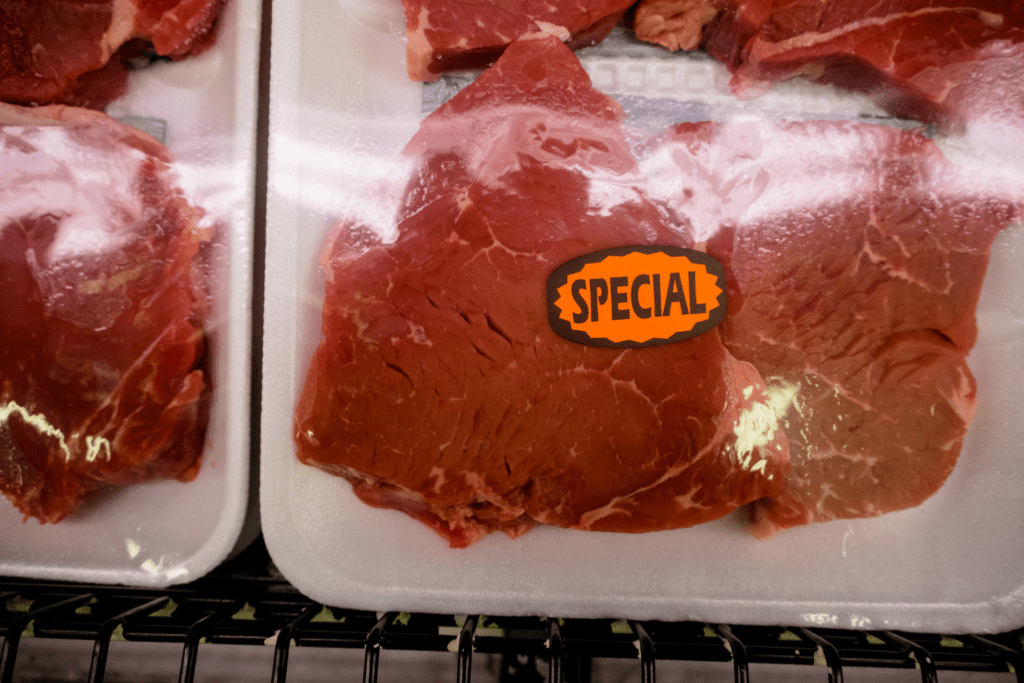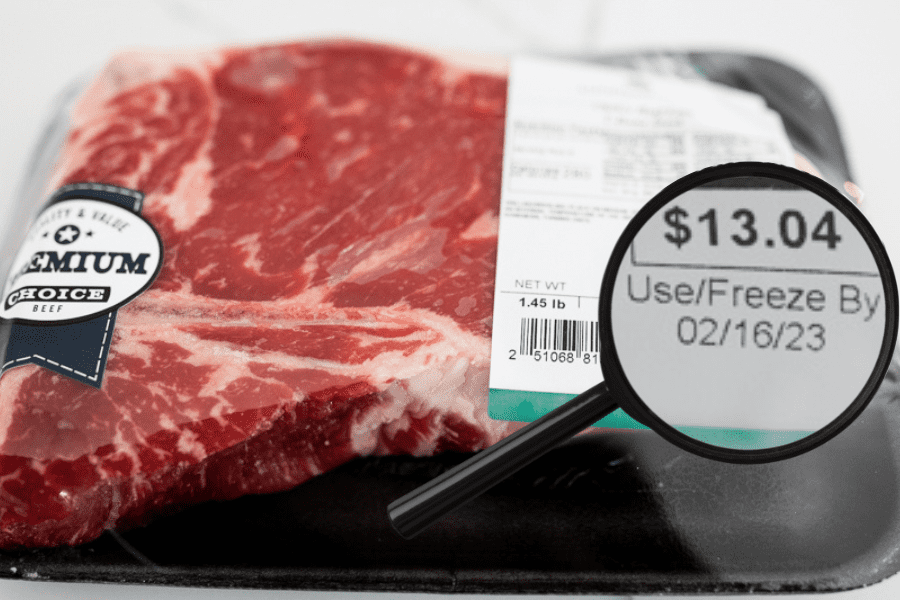Nothing can ruin your appetite quicker than a questionable piece of steak. Why’s the steak a little brown instead of red? Is that a funky smell, or am I imagining things? I’ll give you the 5 signs of how to tell if steak is bad.
Through culinary school and working in professional kitchens, I’ve had my fair share of run-ins with spoiled steak. At this point, I feel like I’ve seen it all. I’ve done all the poking, prodding, and smell tests, so you don’t need to.
Is your steak in good shape to cook or is it going to be an order-takeout kind of night? Let’s find out.

Table of Contents
How to Tell if Steak Is Bad: 5 Signs
Here are the 5 signs you should be aware of to tell if steak is bad:
1. Off-Putting Steak Smell
A fresh piece of raw steak will naturally have a metallic scent. It isn’t overpowering, though. You’d need to stick your face pretty close to the steak to notice it.
What you don’t want is to open the packaging of your steak and be immediately assaulted with a sour ammonia-like stench. Some would say the odor is like smelly cheese or sour milk.
This isn’t an odor that you’d be unsure about. You’d definitely recognize the off-putting smell if it’s present.
The odor is a stinky result of microbes that are decomposing the spoiled steak. The smell is due to the chemicals released from the bad steak or the pathogens themselves.
It’s important to note that dry-aged steak may have a funky smell similar to a “bad” steak. During the dry aging process, the meat releases lactic acid. It’s kind of stinky, like a sour or fermented smell reminiscent of yogurt or cheese.
If you’re unsure you can tell if the steak is bad after the smell test, look for other signs of spoilage. But it’s bad if any astringent scents emanate from the meat, and unsafe for consumption.
2. Discoloration of Steak Could Be Bad
A vacuum-sealed fresh steak will have a dark purple-toned hue from the myoglobin within the meat.
Exposing steak to air will trigger the myoglobin to undergo a chemical reaction. This is when the steak transforms from deep purple to ruby or bright cherry red. In packaging, the bright red liquid isn’t blood, it’s myoglobin and water.
Purple-red hues are the best quality standard to indicate freshness in steak.
Exposing myoglobin to air for longer eventually results in oxidation. And oxidation of steak is not good.
The color of the steak will change from red to brown or grey. This color change alone doesn’t indicate spoilage unless paired with other bad steak characteristics.
A surefire way to tell if your steak is bad is if you notice yellow or green discoloration on the steak. Those colors are the tell-tale signs of mold growth. It’s best to discard the steak than to run the risk of illness!
3. Slimy Steak Is Bad Steak
If you notice a slimy surface resembling a film covering the steak, it’s definitely gone bad.
To the eye, you’ll see a clear or yellow-tinted coating. The steak itself will appear shiner than usual.
When you touch this slime, it will feel slippery and sticky. A fresh steak will feel moist but not slippery.
A slimy coating is a step right before mold growth on degrading meat. You’re better off discarding the steak than running the risk of food poisoning.
4. Dry Steak is Bad Steak
A fresh steak should look plump, firm, and moist. Beef steak past its prime will appear dryer than usual.
If your raw steak looks shriveled or dehydrated, it’s not something you’ll want to consume.
Another indicator is if all the juice has run out of the steak and is lingering in the bottom of the styrofoam container or plastic freezer bag.
The steak should have a slightly moist (but not slimy) feel when you touch it. If a steak is dry, it won’t create the tender, flavorful bite you’re after.
5. Steak Past The Use-By Date / Expiration Date Is Likely Bad
Any package of meat you purchase at the store will have a use-by date or a sell-by date printed on the label.

The use-by date is the same as an expiration date. This is the last possible date of recommended use for the product. Once this date has passed, the quality of the meat will degrade or spoil.
Do not purchase, cook, or consume meat that has surpassed the use-by date.
On the other hand, a sell-by date is only for the store’s reference and inventory management. It’s a suggestion to protect both the retailer and the consumer.
The sell-by date allots enough time to purchase and consume the product within a few days while maintaining peak quality.
The FDA recommends purchasing meat before the sell-by date and the expiration date. This assures optimal longevity and quality of the meat.
What happens if I eat spoiled steak?
A bad steak means one that’s already started decomposing or that has been infected with microbial growth. The steak was probably spoiled if it had yellow or green discoloration. Another indicator of bad steak would be if it had a funky odor or was slimy or dry to the touch.
There isn’t a 100% chance that eating spoiled steak leads to food poisoning, but it’s a strong possibility. Bacteria that grow on rotting steak can cause serious illness. Pathogens like staphylococcus, E. Coli, or salmonella can have life-threatening implications.
Contact your doctor if you’ve consumed bad steak. Keep in mind that dehydration is associated with food poisoning. So, make sure you drink lots of water.
The best way to prevent contracting food poisoning is to immediately discard any steak that shows signs of spoilage.
It’s cheaper to buy another piece of steak than fund a hospital stay, even if it’s ribeye. And as the saying goes, it’s better to be safe than sorry! When in doubt, assume its a bad steak, as painful as that might be.

Related reading: How Long Is Cooked Ground Beef Good For?
How long can I safely store steak?
Plenty of variables will affect how long a steak will last. It all depends on how old it is, what temperatures it was stored at, and what temperature fluctuations it’s been exposed to.
Plus, there’s a slew of environmental factors and unknowns that will affect the longevity of the steak. For example:
- What was its transportation like on the way to the grocery store?
- How carefully did the butchers monitor it before selling it?
- How long did you spend in the car with your steak on your way home?
- Was it a stiflingly hot summer day or a frigid winter one?
While I can’t account for all the unknown variables, I can provide a good framework for handling steak once it reaches your home kitchen. Here are the basics.
At Room Temperature
The maximum time you can keep your steak sitting on the counter at room temperature is 2 hours. However, if it’s hot in your kitchen, no longer than one hour. Hot means any temperature above 90°F.
The steak is potentially dangerous if you pass this time threshold because microbial growth will begin. When in doubt, treat it like spoiled steak and throw it out!
Refrigerated Steak
If you bring home a fresh steak from the grocery store and put it right into your fridge, you’ll have 3-5 days to cook and eat it.
Oxidation will happen, so if you notice some brown or grey-colored portions, the meat is still okay to use if any spoilage factors don’t accompany it.
You’re good to go if it doesn’t have an off-putting odor, an odd slimy, or dry texture, and doesn’t have any yellow or green discoloration.
Pay attention to the package’s sell-by date and expiration date. The steak should still be fine to use for a few days past the sell-by date, but you should cook it or freeze it before its expiration.
Frozen Steak
Freezing your steak will keep it safe for consumption indefinitely. Over time, the quality will degrade. These timelines are for peak quality only:
- Uncooked frozen steak will last between 4-12 months.
- Cooked steak will last 2-3 months in the freezer.
I always suggest storing your meat in the freezer. Then, the night before, transfer the next day’s dinner protein from the freezer to the fridge to thaw.
The FDA recommends that if you store your meat in the freezer for longer than 2 months, you keep it in additional appropriate packaging.
Wrap the original steak packaging in airtight heavy-duty foil. You could also use plastic wrap, freezer paper, or reusable plastic freezer bags to avoid freezer burn.

Bad Steak FAQs
Discoloration isn’t the only tell if steak is spoiled, so don’t toss it just because it isn’t bright red color. As steak is exposed to air, it will oxidize and turn from purple to red to brown or grey color.
As long as your grey/brown color steak doesn’t show another indicator of spoilage like an odor or slimy/dry appearance, it’s not bad and is perfectly fine to cook!
Steak goes bad because over time, steak will oxidize and begin to degrade and break down. This leads to microbial growth by bacteria and mold, which will cause further spoilage. It’s an unavoidable decomposition process that will occur in all fresh meat.
Dry-aged steak doesn’t go bad because the beef is stored in a chamber that circulates cold, dry air as part of the dry-aging process.
Exposure to cold, dry air creates a protective crust along the meat’s exterior. This crust protects the steak from harmful bacteria. Plus, the lack of moisture discourages spoilage.

